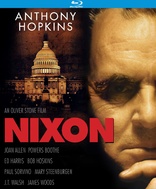Nixon Blu-ray Movie
HomeNixon Blu-ray Movie 
Kino Lorber | 1995 | 1 Movie, 2 Cuts | 212 min | Rated R | May 21, 2019Movie rating
7.4 | / 10 |
Blu-ray rating
| Users | 4.5 | |
| Reviewer | 4.5 | |
| Overall | 4.5 |
Overview
Nixon (1995)
A dramatized biography of former U.S. president Richard Milhous Nixon.
Starring: Anthony Hopkins, Joan Allen, Powers Boothe, Ed Harris, Bob HoskinsDirector: Oliver Stone
| Drama | Uncertain |
| Biography | Uncertain |
Specifications
Video
Video codec: MPEG-4 AVC
Video resolution: 1080p
Aspect ratio: 2.35:1
Original aspect ratio: 2.39:1
Audio
English: DTS-HD Master Audio 5.1 (48kHz, 16-bit)
English: DTS-HD Master Audio 2.0 (48kHz, 16-bit)
Subtitles
English
Discs
Blu-ray Disc
Three-disc set (3 BDs)
Playback
Region A (B, C untested)
Review
Rating summary
| Movie | 5.0 | |
| Video | 4.5 | |
| Audio | 4.0 | |
| Extras | 4.5 | |
| Overall | 4.5 |
Nixon Blu-ray Movie Review
Reviewed by Dr. Stephen Larson May 29, 2019I remember reading an article with Oliver Stone in which the triple Oscar winner was asked about the current craft of filmmaking to which he responded that he'd like to see six to ten different styles flourishing in world cinema. Stone's 1995 biographical epic Nixon is not only an illustrious example of that axiom but also the culmination of styles he experimented with, which began with JFK (1991) and continued in Heaven and Earth (1993), and Natural Born Killers (1994). Nixon shows the evolution of a postmodernist vertical editing, mixture of different film stocks, skewed camera angles, and oscillation between color and black-and-white photography. According to the American Cinematographer's Ric Gentry, Nixon had more than 3,500 shots, 2,000 opticals, and archival footage printed from often grainy reversal stock or transferred from video.
Nixon's variegated aesthetic designs and multiple formats are also a tribute to old masters Stone was influenced by, including Griffith, Eisenstein, Welles, and Chaplin. In fact, world-class cinematographer Robert Richardson told the AC's Gentry that his crew rented a hand-cranked 35mm Mitchell once used by Chaplin for the movie from Lloyd's Camera Exchange in Hollywood. Richardson also received a vintage hand-cranked Cine-Kodak 16mm camera as a gift. Using these antique cameras brought a sense of immediacy to the recreation of President Richard Nixon's campaign rallies, town-hall events, news conferences, and Oval Office meetings. Nixon is also a documentary of faces in the Eisensteinian senses with the facial expressions of Tricky Dick, Nixon family members, and White House cabinet members saying as much if not more than words can convey. At the time of Nixon's theatrical release, some critics noted how Stone patterned the narrative structure and cinematography after Citizen Kane (1941). In a similar vein as Welles, Stone incorporates a non-chronological timeline with story events told out of order. Like Welles's Charles Foster Kane, Stone's rendition of Nixon is a Rosebud wrapped in an enigmatic riddle. As the audience witnesses the turbulent events in Nixon's life and the Cold War unfolds, it probes: Who really was this man?
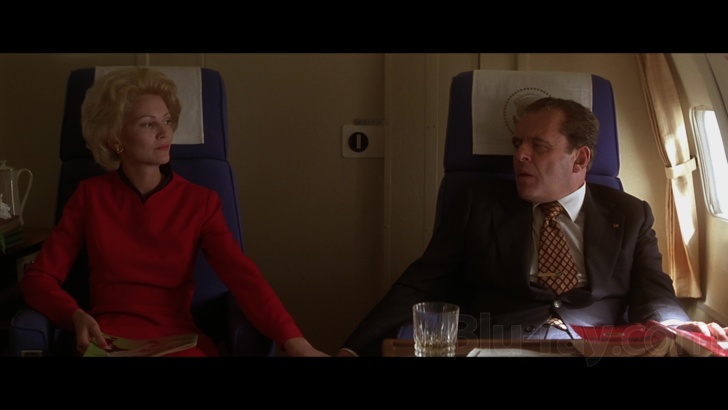
The First Lady and President on their way home from China.
Like JFK, Stone fills Nixon with a troupe of famous and recognizable faces who inhabit prominent historical personages: Anthony Hopkins as the 37th US President; Joan Allen as First Lady Pat Nixon; James Woods as Chief of Staff H.R. "Bob" Haldeman; J.T. Walsh as White House counselor John Ehrlichman; Powers Boothe as Alexander Haig; Paul Sorvino as Secretary of State Henry Kissinger; E.G. Marshall as Attorney General John Mitchell; David Hyde Pierce as whistle-blower John Dean; David Paymer as White House Press Secretary Ron Ziegler; Ed Harris as Watergate burglar E. Howard Hunt; Bob Hoskins as FBI Director J. Edgar Hoover; Mary Steenburgen as matriarch Hannah Nixon; and Tony Goldwyn as Harold Nixon, Richard's older brother. These are just some of the principals and supporting players in a very large ensemble.
When I first watched Nixon, I was overwhelmed by the colossal stage that Stone mounted to tell one of the 20th century's most fascinating and frustrating figures. Upon repeat viewings, I better understood how and why Stone and his editors cut the picture the way they did. Nixon was a brilliant man with an amazing mind and ability to process large amounts of information. The audience sees firsthand the chaotic flow of dialogue and name-dropping cabinet members deliver in a flashback scene early in the film. Nixon is able to take all this in, absorb it, and move on to another topic with remarkable fluidity. He was also a paranoid and corrupt politician. Anthony Hopkins, a Welshian actor playing a Quaker, gives an ingenious interpretation of Nixon's inflections and spontaneous reactions. Like his predecessor, LBJ, Nixon was also a man of many contradictions and conflicting emotions. Stone frequently shows Nixon's state of mind through cutaways to earlier points in his life and lightning flashes of white light cascaded on Nixon and other characters that look like X-rays. Finally, a special note should be made to the editing as it relates to Nixon and his feelings for the Kennedys. Nixon grew up in penurious conditions so he was often jealous and envious of the Kennedys' immense wealth. However, the murders of the Kennedy brothers struck a vital nerve in Nixon. Stone flashes back to the grief and sorrow Richard feels to losing two of his brothers to tuberculosis. In sum, this is epic filmmaking at its very best.
Nixon Blu-ray Movie, Video Quality 
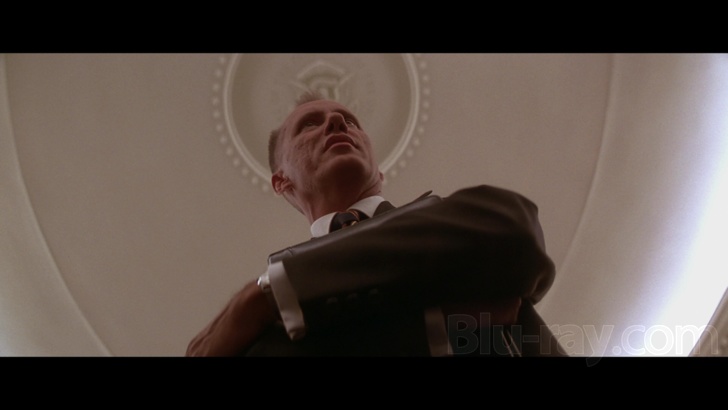
Eleven years after Disney/Buena Vista's Nixon (Election Year Edition), Kino Studio Classics has released a three-disc Special Edition containing both the original 191-minute Theatrical Cut (premiering for the first time in HD on a physical disc) and the extended 212-minute Director's Cut (which was only on the two-disc Disney set). Both cuts are presented in the film's original theatrical aspect ratio of approximately 2.35:1. The TC and DC are encoded on a BD-50 using MPEG-4/AVC. The theatrical version boasts a healthy average video bitrate of 27972 kbps. The authoring and compression on the DC is slightly better than Buena Vista's. The former's 22972 kbps nudges ahead of Disney's mean bitrate of 21496 kbps. While watching Nixon, it's essential to note the diverse lenses and film stocks that Richardson and his camera crew employed. The aforementioned Ric Gentry (in a March 1996 article for AC) reported that Richardson worked with 35mm anamorphic Panavision and E series hard lenses, 16mm with Arriflex and Zeiss lenses, video with a Hi8 Sony camera, Betacam, and a 1970s-model Ikegami. At different times they also utilized footage shot with tube cameras of the '50s and '60s, as well as the already mentioned handcranked 35mm and 16mm cameras. Bluescreen and greenscreen composite screens were inserted to accentuate dramatic moments. In addition, there was nearly an hour's worth of specially-processed imagery.
I've watched different DVD iterations (as well as the Disney Blu-ray) of Nixon a number of times on various HDTVs and projectors so I have a solid grasp of the color timing. Color temperatures on the TC are similar to the ones on BV's 1999 non-anamorphic DVD. Red, lavender, and green for the film's "regular" 35mm photography in the story's present look richly delineated on Kino's TC. Richardson commented to Gentry that he loves "silk" images to contrast with the grainier compositions. The print used is excellent except for film artifacts in form of tiny white specks that occasionally pop up. The archival news footage not only appears grainy but so does the specially shot quasi-documentary footage of the actors (e.g., see Screenshot #15 of Nixon pointing to an questioning audience member). Richardson obviously studied the work of Dorothea Lange and other Depression-era photographers for the black-and-white imagery he captured of Nixon's boyhood town of Whittier, California (see #s 17-20; 38). Gaffer Christopher Strong used a then-new computer-controlled dimmer system to light the Oval Office and other locations that required harsh contrasts between light and dark on Nixon's frame.
The print of the DC that Kino acquired from BV looks strikingly similar to the one released over a decade ago. The 2003 Collector's Edition Series was only letterboxed and the footage added to the DC was in very rough shape. Here, as in the 2008 EE, it has been cleaned up and looks stellar. Screenshot #s 21-30 feature the additional footage from the DC.
The TC and DC both have ten scene selections. (The BV EE boasts thirty-six chapter stops.)
Screenshots 1-20 = Kino Studio Classics Theatrical Cut
Screenshots 21-40 = Kino Studio Classics Director's Cut
Nixon Blu-ray Movie, Audio Quality 
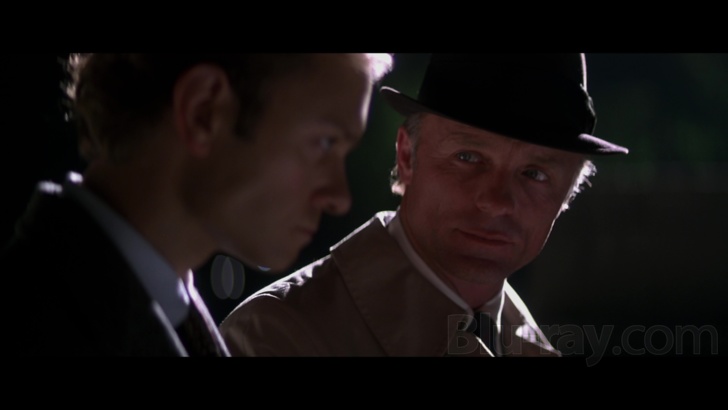
Kino has supplied a DTS-HD Master Audio 5.1 Surround track (2200 kbps, 16-bit) and a DTS-HD Master Audio 2.0 Stereo mix (1558 kbps, 16-bit) on the Director's Cut. The theatrical version also contains a DTS-HD Master Audio 5.1 Surround track (1956 kbps, 16-bit) and a DTS-HD Master Audio 2.0 Stereo mix (1558 kbps, 16-bit). From my research, it appears that commercial cinemas had theaters equipped with either 5.1 Surround or Dolby 4.0 Surround for release prints of Nixon. Stone's film is very dialogue heavy and the center channel/front speakers handle spoken words with crispness and clarity. The bass is outstanding. The bombing of Cambodia sequence delivers some thunderous explosions on the surrounds and .LFE. On the 2008 BD-50 of the DC, BV delivered a propulsive LPCM 5.1 Surround (4608 kbps, 16-bit) that outshines the sound mixes here. It sounded more brisk and dynamic to my ears, although surround activity emanates from the same spots in the film.
John Williams composed mostly a dark, atonal score that cuts into Nixon's personality and his demons. It's always been highly underrated and underappreciated. If you listen carefully to Williams's theme for Nixon, you'll notice some of the same notes he wrote for "The Imperial March"! Trumpet soloist Tim Morrison, who also performed for Williams on his scores for Born on the Fourth (1989) and JFK, delivers warmer, Americana-imbued notes for the cue, Growing Up in Whittier," and for other upbeat moments in Nixon's life. Williams's score is well-balanced across all speakers. "Shenandoah" sounds warm and august as it plays over a photo montage of the actors.
Optional English subtitles are available for both cuts. The Disney offered those as well as English SDH, French, and Spanish subs. You'll notice that compulsory English subs are embedded into the cinema print for some Russian dialogue (see Screenshot #40).
Nixon Blu-ray Movie, Special Features and Extras 
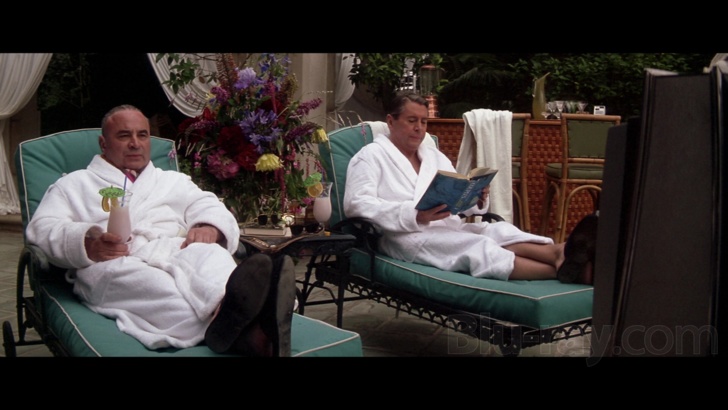
Kino has ported over nearly all the extras that have appeared on DVD and Blu-ray of Nixon. The only missing bonus items are some B-roll footage and additional interviews that appeared on the two-disc M6 Vidéo/Zylo Édition Collector of the film in France, which I own.
DISC 1: DIRECTOR'S CUT
- Audio Commentary 1: Oliver Stone Discusses the Film's Performances, Style & Script - this first appeared on Buena Vista Home Entertainment's 2003 disc and was referred to as "Commentary A" if memory serves correctly. Stone is very chatty and informative of production stories and historical anecdotes. In English, not subtitled.
- Audio Commentary 2: Oliver Stone Discusses the Politics & History of the Era - "Commentary B" on the old DVD release. There are definitely more gaps on this track as Stone addresses said topics. In English, not subtitled.
DISC 2: THEATRICAL CUT
- NEW Audio Commentary by Film Historian Jim Hemphill - Hemphill is admittedly a huge fan of Stone's oeuvre (as is this reviewer) and his enthusiasm is on full display here. He covers many areas in a wide-ranging discussion. In English, not subtitled.
DISC 3: SPECIAL FEATURES
- Deleted Scenes with Introductions by Oliver Stone (58:38, 480i) – Stone introduces the dozen scenes that ended up on the cutting room floor (at least three of which he later assembled for the Director's Cut). Stone is shown in pan and scan while the deleted/expanded scenes are displayed in 2.35:1 letterboxed format. In English, not subtitled.
- Beyond Nixon (35:19, 1080i) - a mid-2000s documentary produced by son Sean Stone that looks back at Nixon's legacy. In English, not subtitled.
- Charlie Rose Interviews Oliver Stone (55:09, 480i) - an hour chat that Rose conducted with Stone in '95 or '96. In English, not subtitled.
- Making-of Featurette (5:00, 480i) - a promotional featurette Hollywood Pictures produced that includes interviews with Stone, Hopkins, Allen, and Woods. In English, not subtitled.
- Theatrical Trailer (4:32, 480i) - this is the same trailer that I remember Hollywood Records put on an "Enhanced CD" of Williams's score.
- Bonus Trailers - SD trailers for Hannibal (2001), When Eight Bells Toll (1971), and The Crucible (1996).
Nixon Blu-ray Movie, Overall Score and Recommendation 
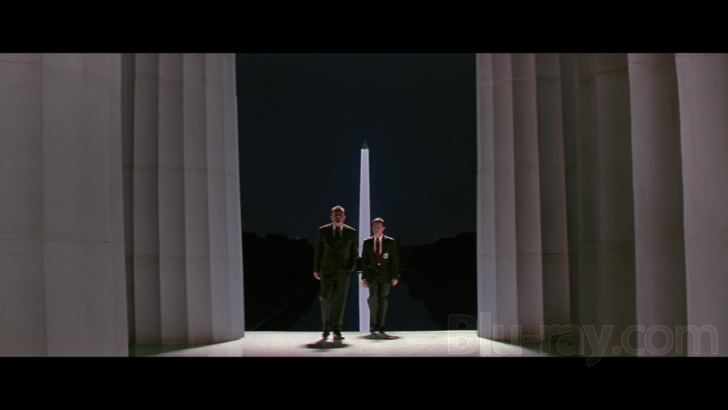
Each time I watch Nixon, I experience a flood of emotions. I laugh, cry, grow angry, and become sad. Stone's staunchest critics have to acknowledge that this is a fair, balanced, and sympathetic treatment of a tragic figure that had a monumental impact on postwar American politics and policy. A strong case can be made that it's Stone's finest overall film. Kino Studio Classics has at last brought the long-awaited theatrical version to high-def. I still feel that the LPCM 5.1 track on Disney's Election Edition packs more of a wallop but the uncompressed sound tracks on both cuts are very good. It is a real treat to have this splendid audio commentary with Jim Hemphill. Some new interviews and featurettes would have vaulted this release to collector's status but it comes VERY HIGHLY RECOMMENDED.
Similar titles
Similar titles you might also like

Syriana
2005

The Last Emperor 4K
Theatrical (4K/BD) and Television (BD) Versions
1987

The Fifth Estate
2013

J. Edgar
2011

Vice
2018

Jackie
2016

Lee Daniels' The Butler
2013

The Irishman
2019

The Ides of March
2011

All the King's Men
2006

Young Mr. Lincoln
1939

Fair Game
2010

Cesar Chavez
2014

A Face in the Crowd
1957

The Iron Lady
2011

Coco Before Chanel
Coco avant Chanel
2009

Hemingway & Gellhorn
2012

Raging Bull 4K
1980

Citizen Kane
75th Anniversary Edition
1941

Factory Girl
2006
